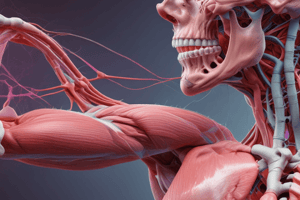Podcast
Questions and Answers
What is the main function of the skeletal system?
What is the main function of the skeletal system?
The main function of the skeletal system is to provide structural support, protection, and leverage for movement.
What is the primary component of bone tissue?
What is the primary component of bone tissue?
The primary component of bone tissue is collagen fibers embedded with mineralized crystalline deposits called hydroxyapatite.
Name two examples of long bones in the human body.
Name two examples of long bones in the human body.
Two examples of long bones are the femur and humerus.
How do flat bones contribute to the human body?
How do flat bones contribute to the human body?
Describe the shape and function of short bones.
Describe the shape and function of short bones.
Where are irregular bones typically found and what distinguishes them?
Where are irregular bones typically found and what distinguishes them?
What are the two main classifications of bones based on their locations within the body?
What are the two main classifications of bones based on their locations within the body?
Define the Central Nervous System (CNS) and its components.
Define the Central Nervous System (CNS) and its components.
What are neurons and what is their role in the nervous system?
What are neurons and what is their role in the nervous system?
What is the function of neurotransmitters in the nervous system?
What is the function of neurotransmitters in the nervous system?
What are glia and what role do they play in the nervous system?
What are glia and what role do they play in the nervous system?
How do the skeletal and nervous systems interplay to maintain bodily integrity?
How do the skeletal and nervous systems interplay to maintain bodily integrity?
Flashcards are hidden until you start studying
Study Notes
Exploring Human Anatomy and Physiology: A Peek into Skeletal and Nervous Systems
Human anatomy and physiology hold the key to understanding our bodies' intricate design. In this exploration of essential structures, we delve into two crucial systems: the skeletal and nervous systems. Both play pivotal roles in maintaining our overall health and wellbeing.
Skeletal System
The human body has 206 bones, providing structural support, protection, and leverage for movement. Bones also store vital minerals like calcium and phosphate, which aid in functions such as blood clotting and regulating hormonal balance.
Bone tissue is composed primarily of collagen fibers embedded with mineralized crystalline deposits called hydroxyapatite. There are four types of bone according to their structure and location within the body:
- Long bones – These elongated shafts have a dense outer layer (cortex) surrounding a hollow center filled with bone marrow, where blood cells develop. Examples: femur, humerus.
- Flat bones – Thin and plate-like, flat bones offer surface area for muscle attachment while protecting internal organs like skull bones, ribs, scapulae.
- Short bones – Cube-shaped, short bones allow multiplane motion and enable fine manipulation tasks, such as those performed by hands and feet. Examples: carpals, tarsals.
- Irregular bones – Varying shapes and sizes, irregular bones are found in areas with complex needs for protection, movement, and anchorage points. Examples: vertebrae, sacrum.
Furthermore, bones can be classified based upon their locations within the body, dividing them into axial and appendicular systems. Axial bones form the central axis of the body and consist mainly of the skull, spine, and sternum, while appendicular bones make up limbs and girdles.
Nervous System
Comprised of nerve cells, known as neurons, and supporting cellular structures, the nervous system facilitates communication throughout our entire body. Neurons carry electrical signals along specialized extensions, allowing us to perceive sensory information from external stimuli, process it internally, and respond accordingly through motor actions.
Two primary components characterize our nervous system:
- Central Nervous System (CNS): Consisting of the brain and spinal cord, the CNS acts as the command center for all neural activity. It receives input from the peripheral nerves, processes information, and sends output via motor nerves.
- Peripheral Nervous System (PNS): Composed of cranial and spinal nerves extending from the CNS to organs and limbs, the PNS contributes significantly to sensation, motor function, and autonomic control of visceral activities.
Neurotransmitters facilitate the passage of signals between neurons across tiny gaps called synapses. They ensure efficient transfer of data both within and between neurological networks. Additionally, glia—non-neuron cells—support, insulate, and nourish neurons, playing critical roles in illness recovery, development, and homeostasis.
In conclusion, appreciating human anatomy and physiology necessitates grasping fundamental concepts revolving around the skeletal and nervous systems. By virtue of these systems' interplay, we maintain bodily integrity and navigate life's endless discoveries and experiences.
Studying That Suits You
Use AI to generate personalized quizzes and flashcards to suit your learning preferences.




